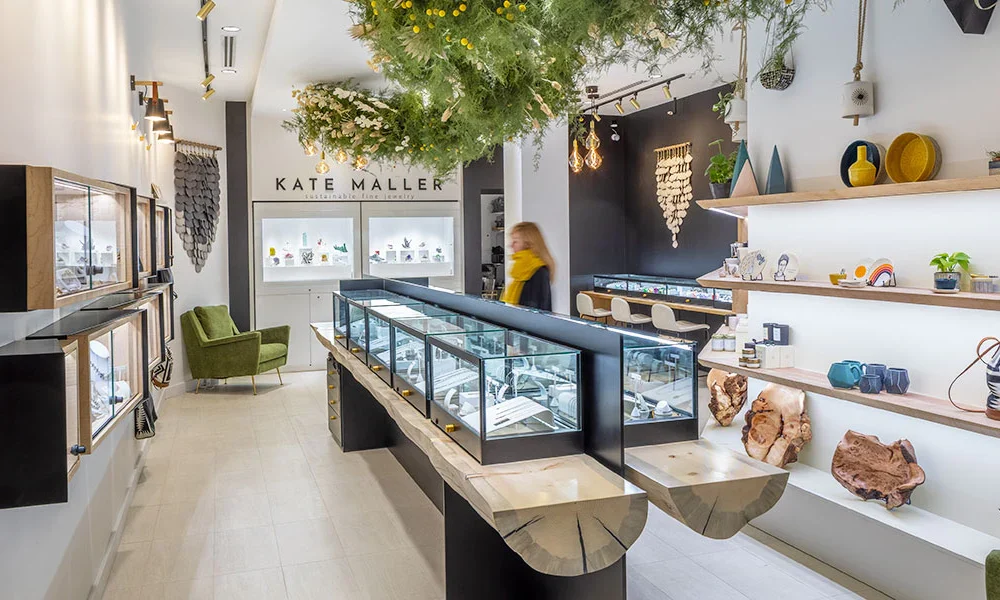In 2019, only 13 percent of fine jewelry purchases were made online. But that number is set to skyrocket in the coming years.
Operating responsibly isn’t easy for any industry, but it’s particularly challenging for jewelers. Supply chains are complex, and implementing more robust standards requires change throughout the process.
Despite these challenges, brands founded on sustainable values are thriving. They are winning the trust of younger consumers and transforming the industry.
Ethical Gold
Buying ethical gold jewelry makes a statement of commitment to sustainability and responsibility. Look for brands prioritizing transparency in their supply chain, which means you can find exactly where the raw materials came from and who crafted the final product.
Ethical gold also prioritizes local and small-scale mining, which can be less impactful than large-scale mining operations. Look for third-party certifications like Fairmined and Fairtrade, which vet and certify mining practices (not just for gold but other precious metals) based on environmental protection, worker rights, and community development investments.
You can also choose jewelry that uses recycled gold, which is melted down from old jewelry, electronics, and even dental crowns. This alternative is more environmentally friendly than extracting fresh gold since it uses less energy, trash, and pollutants during manufacture. Finally, consider using recycled diamonds, which are gaining popularity among high-end jewelry designers like Kate Maller Jewelry. They have less adverse effects on people and the environment than mined diamonds.
Digital Media
The e-commerce revolution is changing the market dynamics in the luxury fine jewelry industry. Young generations, such as millennials and Gen Z, are expected to have a massive influence on the market, with preferences emphasizing self-expression and sustainable design. These consumers also seek experiences and favor bespoke commissions.
In addition, it’s not unusual for millennials to return to the same store after their purchases to bring their pieces in for repairs or customizations. It creates an opportunity for the brand to reinforce the magic they created and re-engage with their customers, resulting in loyalty and retention.
McKinsey predicts that 2025 sales of high-end branded jewelry will grow at an annual rate of 8 to 12 percent, three times faster than the overall market. This growth will accelerate the competition between established jewelry brands, fashion brands, and new direct-to-consumer (DTC) players in the search for individualized, opinionated customers. It is the perfect time for jewelers to embrace sustainability.
Social Media
Building consumer trust is one of the biggest challenges for fine jewelry and premium ultra-luxury watches. Because of the high price tag and sensitivity around gems and metals, consumers have researched and want to know that they are making the right choices for the environment, social impact, and craftsmanship.
Social media can help here, too. By collaborating with influencers or organizations that prioritize sustainability and align with your brand values, you can amplify your messages to reach new audiences.
Transparency
The luxury fine jewelry industry must clearly state its commitment to sustainability. It includes using recycled or responsibly sourced materials and ensuring fair labor practices. It also involves creating beautiful pieces that consumers can feel good about wearing.
Another critical element of sustainability is transparency. Consumers are increasingly interested in knowing where their products come from and how they are made. It can assist individuals in making well-informed purchasing decisions and foster their confidence in a particular brand.
AI-driven parametric tools can streamline the design process and enable designers to explore innovative structures and intricate patterns, reducing waste throughout the production chain. However, companies must strike the right balance between human creativity and AI assistance. Those focusing on collaboration and training programs can empower employees with the skills necessary to use this powerful technology without jeopardizing their unique artistic processes. It enables them to create more diverse and captivating designs that are sure to capture the attention of today’s discerning consumers.

